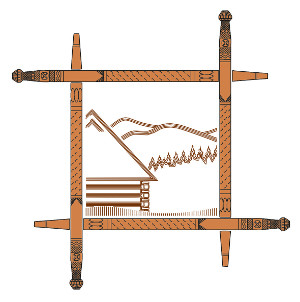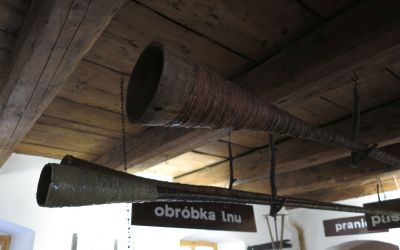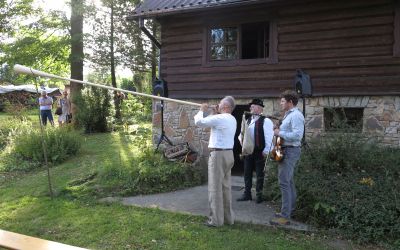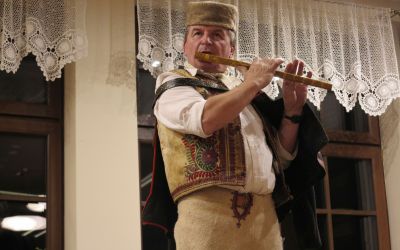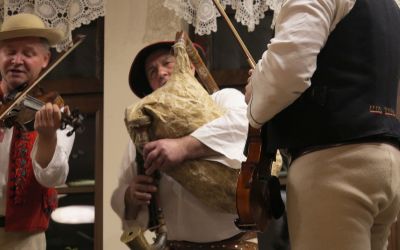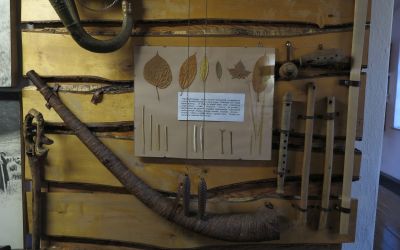
The first lip aerophones were invented while grazing sheep from plantain leaves, pears or blades of grass. Aerophones were particularly widespread in the area of the Carpathian Arch.
The oldest instrument were rallies consisting of a sheepskin bag and a blower that forced air into the bag. This instrument was recognized by UNESCO as a cultural heritage in 2015. Gajds occurred in the region of the Silesian Beskids, the air is forced into them by means of a puff (Trójwieś). Initially, this instrument accompanied the singing, and then together with the violin formed a traditional composition. Three violinists and a bass appeared at bigger parties. Carnival tradition is connected with the bass, it is still alive in Cieszyn Silesia. The bass burial has been held so far in Piwnica Targowa, now in the National House. The party ends at midnight by removing the string and covering the instrument with the shroud.
Bagpipes consisted of a leather bag and one melodic pipe and burdon pipe. Air is blown into the bag through a tube, called a duhac mouthpiece or with the help of the bellows, the air escapes from the bag, passing through all the pipes that sound at the same time. Bagpipes allow you to play melodies without stopping for breath. "Gajda was made of goatskin, which was turned inside out. From the inside, the rear part of the instrument was tied, it was finished with a carved goat head, in the mouth of which a pipe with a horn trumpet was placed. In one leg there was a mouthpiece for blowing air, in the other leg a bit or bass, which is bass for playing in two tones. Air passed through the pipe and bittern through the so-called Carnation made of wild lilac. The construction of the carnation is the same as for the organs. Adjusting the two tones in the bass performs a gajdosz by quickly and suddenly pressing the bellows.
Pipes belong to a large group of shepherd's instruments. One-hole pipe is still used. Called shepherd or Lent. It is made by highlanders from the branches of the thorns of rose or sycamore. This instrument, which until now has been in widespread use of shepherds, gave the basis for the Żywiec scale, with the formula f, g, a, h, c, d, es and had a direct impact on the melody of the songs of this region. Piszczały met in Koszarawa, Korbielów, Sopotnia Mała. According to residents, it was also used to support and even defend. Wooden instruments were about 60 cm and a passage thickness of 3.5 cm with seven lateral holes on a scale characterized by Aeolian Seventh and Lydian Quart. In 1932, the composer Michał Kondracki gave such information about this instrument: "an ancient shepherd's fujara, a long hollow stick, with several holes issuing several tones, half and full-tone intervals within the fifth, with a soft sound similar to the low tones of the flute. Until World War II, they were available at fairs. The shepherd's wooden horn was called shepherds' club , this name comes from legania - leaning on the fence while trumpeting. It was made of birch wood, split, hollowed out and then compressed with small flagella rings, the craftsmanship was wooden. They were from 140 cm to 170, usually horn-shaped with a diameter more often 3 cm narrower and 15 cm wider. Juhasi played on the horn conventional signals and notifying about the beginning and end of grazing or scare off wolves. Seweryn Goszczyński in 1832 wrote a report on the thrombite: Ligawka mainly served to communicate with the flock, her voice led the sheep to the pasture, she gathers as many times as she distracts and calls the barracks for the night. Among the shepherd's instruments Piszczałka, shepherd's fujara was commonly found in the Silesian and Żywiec Beskids. In the study of the scale occurring in the Żywiec region, it is characterized by the Lidian quart and Aeolian seventh S. S. Stoinski states that its source is sound material obtained on a shepherd's pipe without lateral holes with longitudinal or transverse blowing. The length of the pipe must be adapted to the player so that he reaches the index finger of the outlet opening to alternately close and open it. This instrument gives aliquots from the 3rd to the 7th harmonic series. Six-pipe pipes were produced by shepherds, equivalent to the longitudinal alto flute.
Shepherd's horn instrument similar to thrombite, but curved. Sycamore or alder wood is used for their production. The entire manufacturing process coincides with the production of thrombity.
Thrombita is a very important instrument that also fulfills a communication function between shepherds in Sasha and the village population. The instrument, extremely associated with pastoral culture, was made of willow or aspen reaching up to 4 meters. Its shape resembles a wooden trumpet. Bogumił Hoff and geographer Ludomir Sawicki write about the thrombites in the Silesian Beskids, who describes the thrombite from Cieszyn Silesia: "the only object that is really old, but now rare, is a hut trunk (fujara) 4 meters long, made of pine tree. Only the old shepherds have already grayed, e.g. from the village of Brenna, they still know the art of how to cut such long and thin stumps in half, how to gouge them out on the inside and tie both halves together with bark. The tone of this instrument is soft, gentle and prolonged, but it is not easy to get it out of the fujara . The construction of the thrombity consists of: body, vocal spell and mouthpiece. Smooth spruce trunk was used for its production. Trumpets from the Silesian Beskids are sealed with cherry bark. During the game, the instrument rests on the branches of a tree, hummingly so that the voice goblet is directed higher. The outstanding creator Jan Kawulok produced, among others for Cepelia, about 25 gajd, 30 pipes, 12 thrombites, 10 shepherd horns. The production of folk instruments was his great passion and great talent. He was also described as a virtuoso of playing on raids, from which he was able to extract unique sounds. Sheep usually responded to the sound of thrombite and obediently went to a wooden milking parlor.




